
The Battle of Pavia, fought on the morning of 24 February 1525, was the decisive engagement of the Italian War of 1521–1526 between the Kingdom of France and the Habsburg Empire of Charles V, Holy Roman Emperor as well as ruler of Spain, Austria, the Low Countries, and the Two Sicilies.

The Republic of Genoa was a medieval and early modern maritime republic from the years 1099 to 1797 in Liguria on the northwestern Italian coast. During the Late Middle Ages, it was a major commercial power in both the Mediterranean Sea and the Black Sea. Between the 16th and 17th centuries, it was one of the major financial centers in Europe.
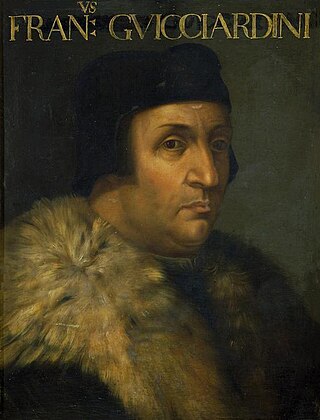
Francesco Guicciardini was an Italian historian and statesman. A friend and critic of Niccolò Machiavelli, he is considered one of the major political writers of the Italian Renaissance. In his masterpiece, The History of Italy, Guicciardini paved the way for a new style in historiography with his use of government sources to support arguments and the realistic analysis of the people and events of his time.
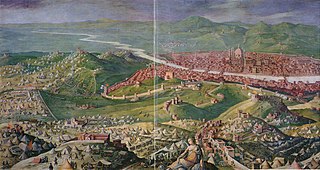
The War of the League of Cognac (1526–30) was fought between the Habsburg dominions of Charles V—primarily the Holy Roman Empire and Spain—and the League of Cognac, an alliance including the Kingdom of France, Pope Clement VII, the Republic of Venice, the Kingdom of England, the Duchy of Milan, and the Republic of Florence.

The First Italian War, or Charles VIII's Italian War, was the opening phase of the Italian Wars. The war pitted Charles VIII of France, who had initial Milanese aid, against the Holy Roman Empire, Spain and an alliance of Italian powers led by Pope Alexander VI, known as the League of Venice.

The Duchy of Sora was a semi-independent state in Italy, created in 1443 by King Alfonso I of Naples and dissolved in 1796. It occupied the south-eastern part of what is today Lazio, bordering what is now Abruzzo. Its capital was first Sora, and later, under the Boncompagni family, Isola di Sora.

The siege of Florence took place from 24 October 1529 to 10 August 1530, at the end of the War of the League of Cognac. At the Congress of Bologna, the Medici Pope Clement VII and Emperor Charles V agreed to restore the Medici family in Florence. A large Imperial and Spanish army under Philibert of Châlon, Prince of Orange and Pier Maria III de' Rossi surrounded the city and after a siege of nearly ten months, captured it. They overthrew the Republic of Florence and installed Alessandro de' Medici as the ruler of the city.
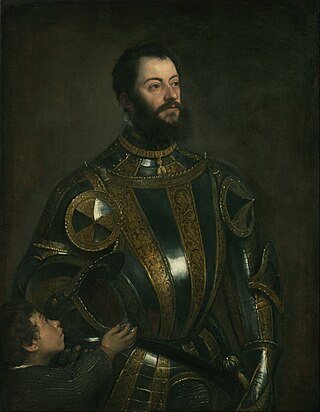
Alfonso d'Avalos d'Aquino, 6th Marquis of Pescara, 2nd Marquis of Vasto, was an Italian condottiero of Aragonese origins, renowned for his service in favour of Charles V, Holy Roman Emperor and King of Spain.
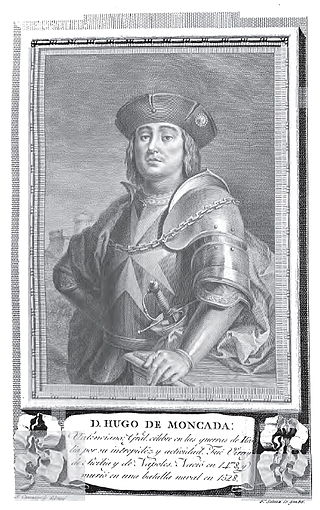
Hugo de Moncada a.k.a. Ugo de Moncada, was a Spanish political and military leader of the late 15th and early 16th century. He served as General of Ocean and Land, Viceroy of Sicily, 1509–1517, Viceroy of Naples, 1527 - 1528.
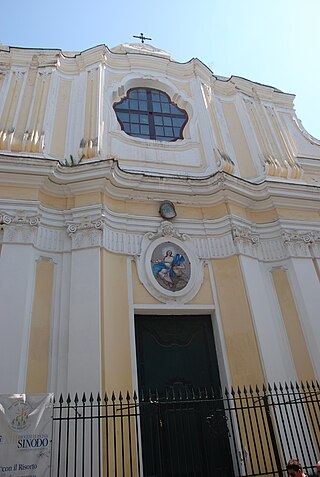
The Diocese of Ischia is a Latin diocese of the Catholic Church in Campania, southern Italy. It is a suffragan of the Archdiocese of Naples. The diocese comprises the entire island of Ischia, which contains seven communes divided into two circumscriptions. In 1743, the population was about 4,000. The city of Ischia constituted one single parish, with two religious houses of men and one of women. In 2018, the population of the town of Ischia was 20,118.
The Battle of Landriano took place on 21 June 1529, between the French army under Francis de Bourbon, Comte de St. Pol and the Imperial–Spanish army commanded by Don Antonio de Leyva, Duke of Terranova in the context of the War of the League of Cognac. The French army was destroyed and the battle's strategic result was that the struggle between Francis I of France and Charles V, Holy Roman Emperor for control of northern Italy was temporarily at an end.

Giovanni II Ventimiglia y Moncada, 6th Marquis of Geraci was a Sicilian aristocrat, a member of the prominent House of Venitmiglia.
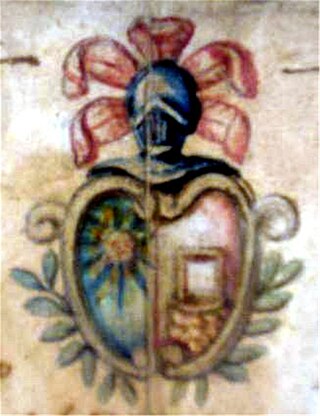
Pozzo Ardizzi surname comes from the city of Vigevano province of Pavia, Italy, which was formed around the middle of the fifteenth century from a branch of the family that is separated from the noble surname Ardizzi.

The Battle of Capo d'Orso, sometimes known as the Battle of Cava and the Battle of Amalfi, was a naval engagement taking place over two days, on April 28 and April 29, 1528, during the War of the League of Cognac. A French fleet inflicted a crushing defeat on the fleet of the Kingdom of Naples under Spanish command in the Gulf of Salerno, where Spanish forces trying to break the French blockade of the city met the French fleet.
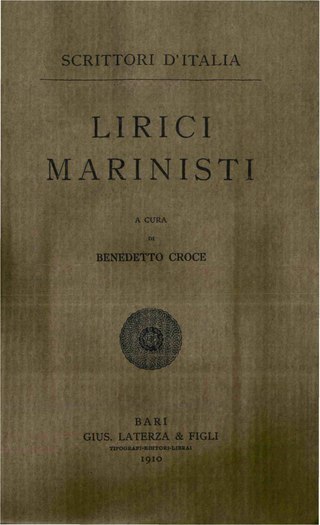
The Scrittori d'Italia was an Italian book collection, published by Giuseppe Laterza & figli from 1910 to 1987 in Bari. The series was born with the intent to define and explain a cultural canon of the new Italy, disassociating from a culture yet considered too much based on the classic of the humanism, and choosing to represent also the civil history of the newborn Italian State. The original work plan included 660 volumes, of which 287 were actually published for a total of 179 works.
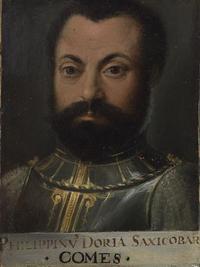
Filippo or Filippino Doria was a Genoese admiral from a cadet branch of the Doria family.

The Ceva Grimaldi are an Italian noble family established in Southern Italy since the 16th century but whose origins are in Piedmont and Liguria and date back to the 10th century. The main titles associated with this branch of the Ceva family are Marchese di Pietracatella and Duca di Telese.
The siege of Novara took place in the summer and autumn of 1495 during the Italian War of 1494–1495. While king Charles VIII of France was retreating to the north after facing rebellions in the recently conquered Kingdom of Naples, and managed to escape the destruction of his army at the Battle of Fornovo, his cousin and future king Louis d'Orleans opened a second front by attacking the Duchy of Milan and occupying the city of Novara. In an effort to retrieve it, the Milanese army and their League of Venice allies besieged Novara for three months and fourteen days. Suffering from severe starvation and disease, the French lost about 2000 soldiers before Louis had to surrender and withdraw.

Francesco Zurolo also called Francesco Zurulo or Francesco Zurlo was an Italian feudal lord, baron and leader.

















